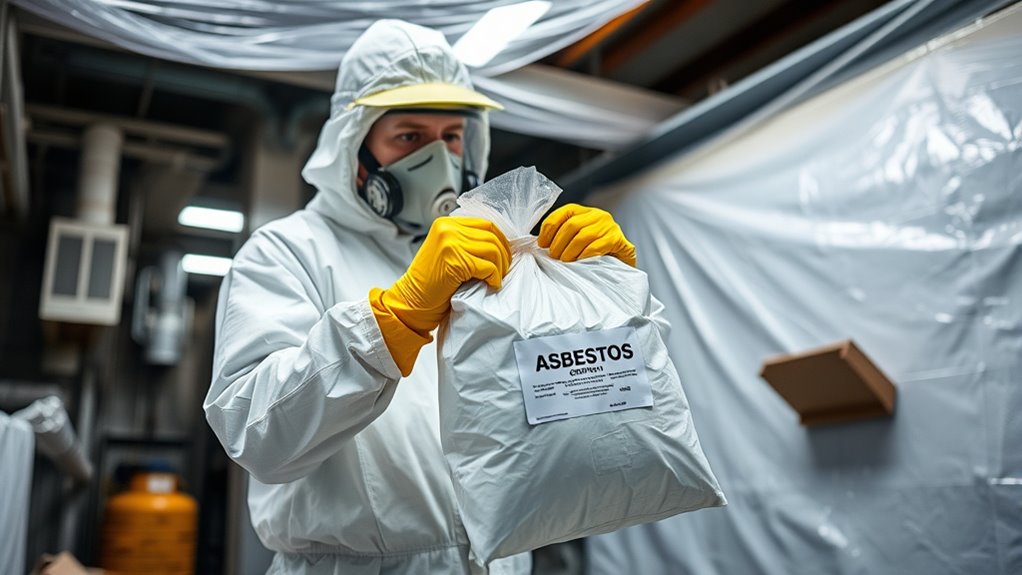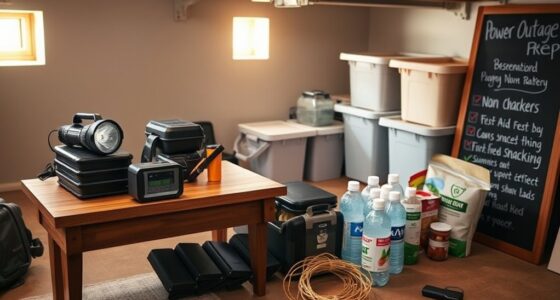Safe asbestos removal involves careful planning, understanding the risks, and following strict safety standards to protect your health. You need to identify asbestos-containing materials, use proper protective gear, and contain the area to prevent fiber spread. It’s best to hire licensed professionals who follow regulated procedures for removal and disposal. Proper inspection and clearance testing assure the space is safe for re-entry. If you want to learn more about the steps involved, continue exploring the process in detail.
Key Takeaways
- Proper assessment and testing by licensed professionals are essential to identify asbestos-containing materials accurately.
- Use appropriate personal protective equipment (PPE) and containment measures to prevent fiber release during removal.
- Employ specialized techniques like wet removal, HEPA filtration, and negative pressure enclosures to minimize exposure risks.
- Follow legal regulations for safe disposal of asbestos waste, including proper sealing and labeling of containers.
- Conduct post-removal inspections and obtain clearance certification to ensure the area is safe for occupancy.
Understanding Asbestos and Its Risks

Understanding asbestos and its risks is essential because exposure can cause serious health problems. Asbestos fibers are tiny, microscopic particles that can become airborne when materials containing asbestos are disturbed. When inhaled, these fibers pose significant health threats, including lung diseases and cancers such as mesothelioma. The asbestos exposure risk increases with the amount of asbestos fiber health exposure and the duration of contact. Even low levels of exposure can be dangerous over time, making it *crucial* to recognize how easily these fibers can become airborne. Knowing these risks helps you understand why proper removal and handling are *vital* to prevent health issues. Proper safety measures during removal are essential to minimize the risk of fiber release and ensure a safe environment. Staying informed about asbestos fiber health and exposure risk is the first step toward ensuring safety during removal or renovation projects.
Identifying Asbestos-Containing Materials
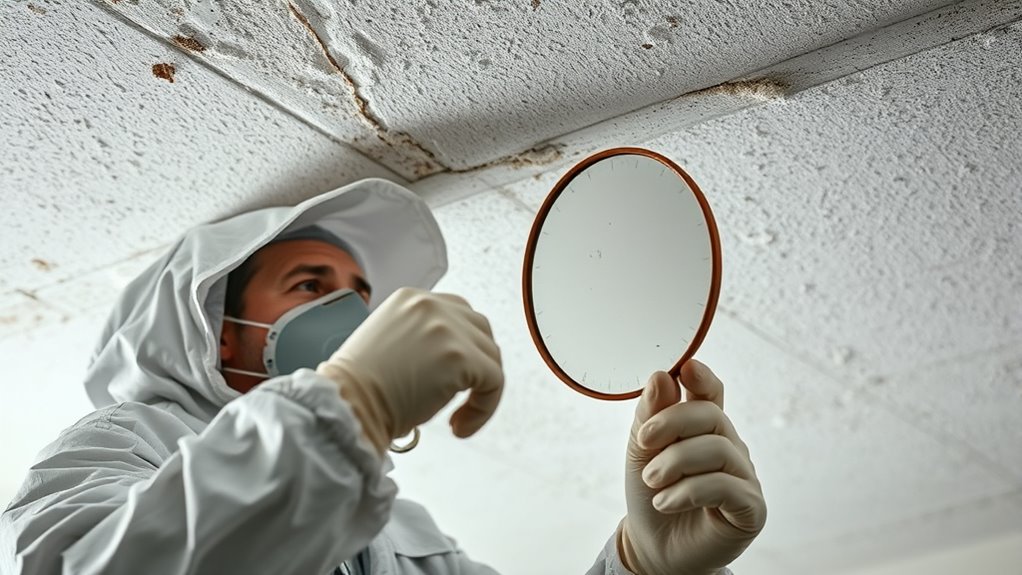
Identifying asbestos-containing materials is a crucial step before beginning any removal or renovation work. You need to recognize materials that may contain asbestos based on its fiber properties—fibers are durable, heat-resistant, and can become airborne when disturbed. Historically, asbestos was used in insulation, roofing, flooring, and other building materials due to these properties. Look for textured paints, popcorn ceilings, vinyl floor tiles, and pipe insulation, especially in buildings built before the 1980s. Always check labels and manufacturer information, but remember that asbestos isn’t always obvious visually. If you suspect a material contains asbestos, avoid disturbing it. Professional testing is essential for accurate identification, helping you determine the right safety procedures for handling hazardous materials safely. Additionally, Natural Language Processing (NLP) technology can assist experts in analyzing building materials and documentation to identify potential asbestos-containing products more efficiently.
Legal Regulations and Safety Standards
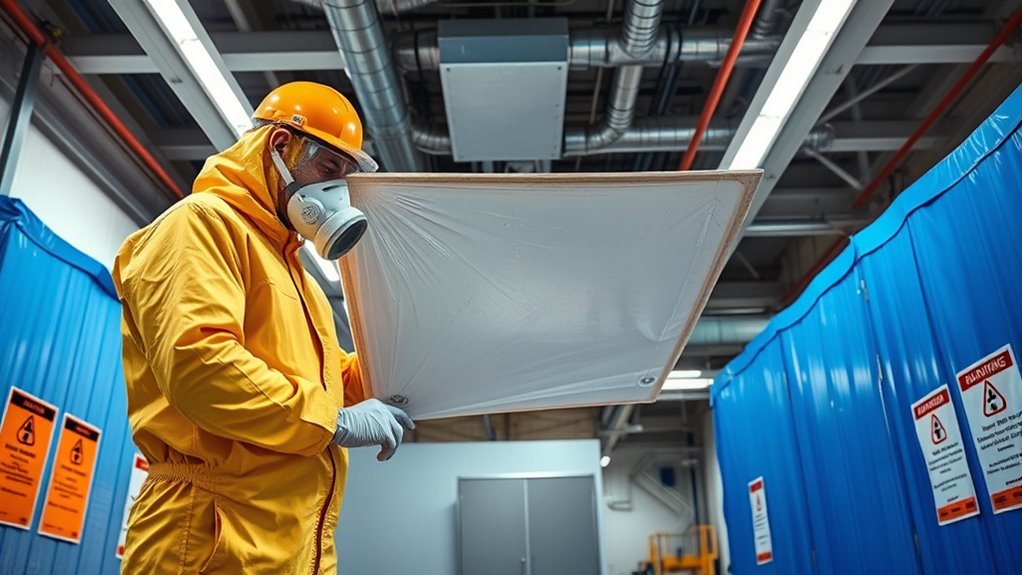
Before you start removing asbestos-containing materials, it’s important to familiarize yourself with the legal regulations and safety standards that govern asbestos handling. These laws ensure safe asbestos testing, proper removal, and disposal, minimizing health risks. Non-compliance can lead to severe legal liabilities, fines, or shutdowns. Always verify local regulations before beginning work. Keep in mind that licensed professionals must perform asbestos testing and removal in many jurisdictions. Safety standards mandate specific protective equipment, containment procedures, and waste disposal methods. Ignoring these standards not only endangers health but also exposes you to legal consequences. To stay compliant, regularly update yourself on regulations and ensure your project aligns with current safety standards. Proper adherence protects your team, the environment, and your legal standing. Additionally, understanding regional legal resources can help you navigate specific requirements and ensure full compliance.
Planning and Preparing for Removal

Before starting asbestos removal, you need to conduct a thorough site assessment to identify all contaminated areas. Make sure you have a complete safety equipment checklist to safeguard yourself and others during the process. Proper planning ensures a safe, efficient removal that complies with regulations. Incorporating industry trends into your planning can help you stay up-to-date with the latest safety standards and best practices.
Site Assessment Procedures
Effective site assessment is crucial for a safe and efficient asbestos removal process. You need to identify asbestos types present and understand their historical uses to determine proper handling methods. Conduct a thorough inspection to locate all asbestos-containing materials (ACMs) and assess their condition. This helps prevent accidental exposure and guides removal strategies. Key steps include:
- Identifying different asbestos types and their locations
- Reviewing building history for asbestos use
- Evaluating the condition of ACMs
- Planning containment and ventilation measures
- Documenting all findings for compliance
Understanding the specific asbestos types and their historical uses allows you to choose appropriate removal techniques, reducing risks for workers and occupants. Proper planning based on detailed assessments ensures a smoother, safer removal process. Additionally, knowledge of signs of spoilage and proper handling procedures can further enhance safety during removal activities.
Safety Equipment Checklist
Once you’ve completed a thorough site assessment and identified asbestos-containing materials, it’s time to focus on planning and preparing for removal. Your safety equipment checklist is essential to guarantee proper protection. First, gather protective clothing, including disposable coveralls, gloves, and a respirator rated for asbestos fibers. Ensure your respirator fits snugly and has the appropriate filters. Keep an emergency response plan ready in case of accidental exposure or equipment failure. Make sure all team members are trained on proper donning and doffing procedures to prevent contamination. Regularly inspect safety gear for damage or wear. Proper exfoliation techniques can help in maintaining skin health during handling of contaminated materials. By preparing these items in advance, you minimize risk and ensure a safer, more efficient asbestos removal process.
Personal Protective Equipment and Safety Gear
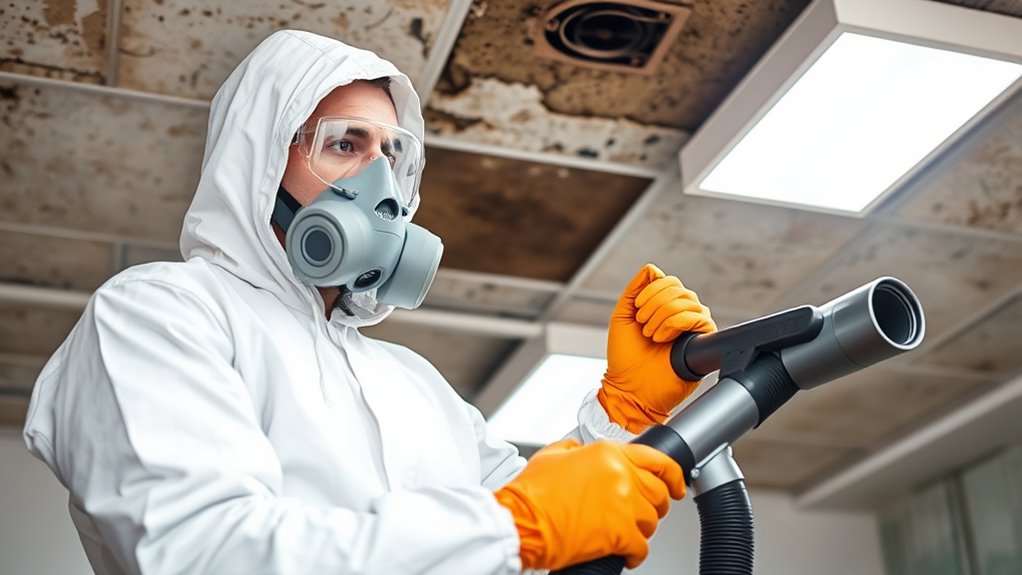
When working with asbestos, wearing the right personal protective equipment (PPE) and safety gear is essential to prevent exposure to harmful fibers. Proper PPE includes a well-fitted respirator, which must have a good respirator fit to guarantee no fibers bypass the mask. Gloves should be carefully selected to provide durability and chemical resistance, minimizing skin contact. You also need protective coveralls, eye protection, and a head covering to reduce risks. Remember, PPE is only effective if used correctly and consistently.
- Guarantee respirator fit tests are performed regularly
- Choose gloves that resist tearing and chemical penetration
- Use disposable coveralls to prevent fiber transfer
- Wear goggles or face shields for eye safety
- Maintain PPE and replace damaged gear promptly
Proper Removal Techniques and Equipment
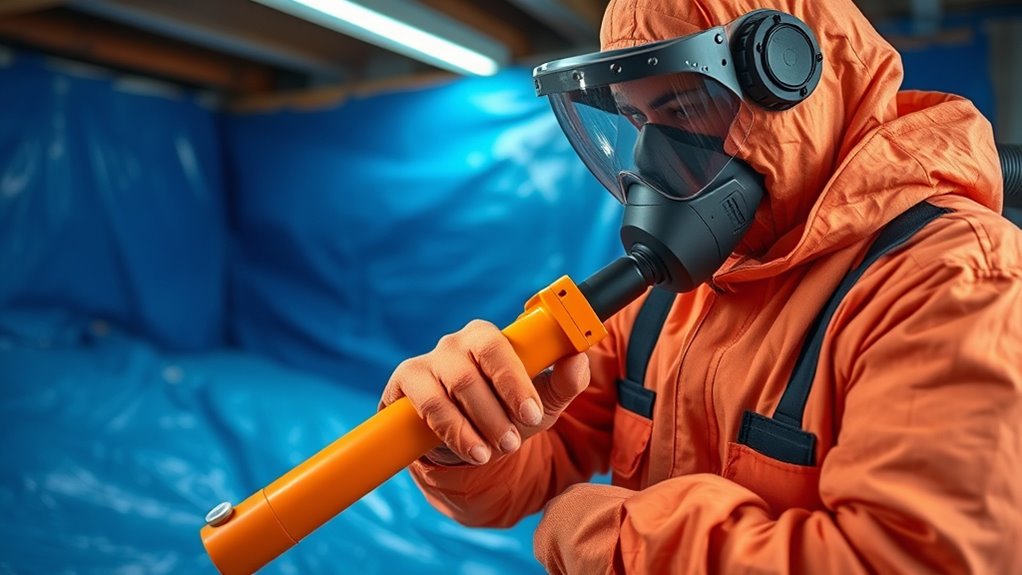
To guarantee safe asbestos removal, you need to use the right protective gear and follow strict containment procedures. Specialized removal equipment helps minimize airborne fibers and prevent contamination. Proper techniques and tools are essential for a safe and effective removal process. Additionally, implementing vetted safety practices ensures compliance with health standards and reduces risks.
Protective Gear Usage
Using the proper protective gear is essential to safely remove asbestos and prevent health risks. Your respirator must fit snugly to guarantee no airborne fibers escape, emphasizing the importance of respirator fit. Gloves should be durable enough to resist tears and punctures, protecting your skin from asbestos particles. Always wear a full-body suit to minimize skin exposure and prevent contamination spread. Remember, proper gear not only shields you but also reduces the chance of asbestos fibers transferring to other areas. Additionally, choosing the right airless paint sprayer can facilitate safer handling and application, reducing the need for extensive protective measures during painting tasks.
Containment Procedures Implemented
Implementing proper removal techniques and using specialized equipment are crucial steps to guarantee asbestos is safely contained. You must follow strict procedures, including effective asbestos fiber analysis, to identify contamination levels accurately. Proper containment prevents fiber spread, protecting workers and the environment. Equipment like negative pressure enclosures and HEPA-filtered vacuums are essential for safe removal. Additionally, understanding asbestos remediation financing options ensures the project stays within budget while maintaining safety standards. The table below highlights key components:
| Technique | Equipment Used | Purpose |
|---|---|---|
| Air Monitoring | HEPA vacuums, air scrubbers | Detect fiber presence |
| Containment Barriers | Plastic sheeting | Prevent fiber escape |
| Safety Protocols | Proper PPE, signage | Protect workers and site |
These steps ensure asbestos removal complies with safety standards and supports efficient remediation. Understanding asbestos mitigation techniques further enhances the effectiveness of the process.
Specialized Removal Equipment
Proper removal techniques rely heavily on specialized equipment designed to safely extract asbestos fibers without dispersing them into the environment. You’ll need tools like HEPA vacuums, negative pressure enclosures, and wet removal systems to minimize fiber release. Proper equipment maintenance guarantees these devices operate at peak efficiency, reducing contamination risks. Air filtration is vital, capturing airborne fibers before they escape into the environment. Regularly checking and maintaining your equipment prevents malfunctions that could compromise safety. Remember, using the right tools and maintaining them properly protects both your team and the environment. Investing in quality equipment and routine inspection is indispensable for a safe removal process. Key points include:
- HEPA filtration systems
- Negative pressure enclosures
- Wet removal techniques
- Routine equipment maintenance
- Air filtration accuracy
Additionally, understanding the importance of Volkswagen Tuning can inspire safer and more effective modifications when working on vehicle performance upgrades.
Containment and Isolation Procedures

To prevent the spread of asbestos fibers during removal, containment and isolation procedures are vital. You’ll set up physical barriers like plastic sheeting and negative air pressure systems to contain asbestos within a controlled area. This prevents fibers from migrating to other parts of the building. It’s important to address asbestos myths—many believe it’s always easy to identify asbestos, but historical uses show how widespread and hidden it can be. Proper containment minimizes exposure risks for workers and occupants alike. You’ll also use warning signs and restrict access to guarantee no one unintentionally enters contaminated zones. These steps are essential for safe removal, helping to make certain asbestos fibers stay contained until proper disposal, reducing health risks associated with asbestos exposure.
Waste Disposal and Decontamination
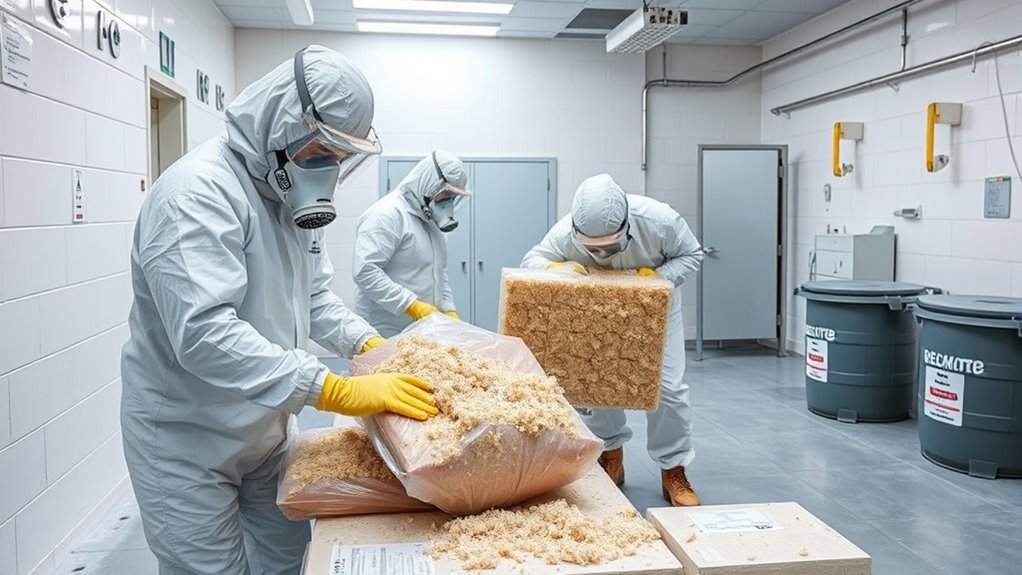
After asbestos removal is complete, carefully managing waste disposal and decontamination is crucial to guarantee safety. Proper disposal prevents asbestos fiber inhalation and environmental contamination. Use designated, labeled containers for asbestos waste, and follow strict asbestos disposal methods to avoid exposure. Confirm all contaminated materials are sealed tightly to prevent fiber release. Decontaminate tools and PPE thoroughly to eliminate residual asbestos fibers. Keep waste records for compliance and future reference. Remember these key points:
Proper asbestos waste disposal and decontamination are essential for safety and environmental protection.
- Use approved disposal containers
- Seal waste securely
- Follow local asbestos disposal regulations
- Decontaminate all equipment
- Limit access to waste areas
Post-Removal Inspection and Clearance Testing

Once the asbestos removal process concludes, conducting a thorough post-removal inspection and clearance testing guarantees the workspace is safe for re-entry. This step verifies that all asbestos fibers have been effectively removed through asbestos testing, ensuring no health risks remain. Clearance certification confirms the area meets safety standards set by regulatory agencies. During inspection, professionals check for residual contamination, proper containment, and cleanup.
| Key Step | Purpose |
|---|---|
| Asbestos Testing | Detect remaining asbestos fibers |
| Clearance Certification | Official approval for safe re-entry |
| Final Inspection | Ensures the area is free of asbestos hazards |
Hiring Certified Professionals vs. DIY Removal

When it comes to asbestos removal, expert skills are essential to do the job safely and effectively. Certified professionals follow strict safety protocols you might not be aware of, reducing risks to your health. Considering these factors, hiring experts often makes the most sense over attempting a DIY removal.
Expert Skills Matter
Hiring certified professionals for asbestos removal is essential because their specialized training guarantees the job is done safely and effectively. With proper expertise, they minimize asbestos exposure risks and ensure removal safety. DIY removal might seem tempting, but without proper skills, you risk releasing dangerous fibers into the air. Professionals understand how to contain asbestos and use advanced equipment to prevent contamination.
Remember, asbestos exposure can have serious health consequences.
Key reasons to choose experts include:
- Proper handling of asbestos-containing materials
- Use of appropriate protective gear
- Correct disposal procedures
- Knowledge of local regulations
- Experience in managing complex situations
Safety Protocols Ensured
Choosing to hire certified professionals guarantees that strict safety protocols are adhered to throughout asbestos removal. You avoid falling for asbestos myths that downplay the dangers or suggest DIY methods are safe, which can lead to health risks. Certified experts follow thorough safety procedures, including proper containment, protective gear, and air quality monitoring. They’re trained to handle historical asbestos cases where improper removal caused widespread contamination and health issues. By trusting professionals, you minimize exposure and ensure compliance with regulations. DIY removal often overlooks these critical safety steps, increasing the chance of asbestos fibers dispersing into your home. Ultimately, professional removal guarantees a safer environment, protecting you and your loved ones from long-term health hazards linked to asbestos.
Frequently Asked Questions
How Long Does the Asbestos Removal Process Typically Take?
The duration estimate for asbestos removal varies based on factors like the size of the area and material type. Typically, the process steps include assessment, sealing, removal, and cleanup. You can expect it to take anywhere from a few days to a week. Keep in mind, proper safety measures are essential, so rushing could extend the timeline. Planning ahead guarantees a smooth and efficient removal process.
What Are the Costs Associated With Professional Asbestos Removal?
Think of asbestos removal costs as a puzzle—each piece, from materials to labor, influences your total. You should expect a cost estimation that varies based on the project’s scope, with professional removal often ranging from $1,500 to $3,500 or more. To avoid surprises, plan your budget carefully, considering factors like location and asbestos amount. Proper budget planning guarantees safe, effective removal without breaking your bank.
Can Asbestos Be Safely Removed From a Small Residential Area?
You can safely remove asbestos from a small residential area by first scheduling asbestos testing to confirm its presence. Once confirmed, hire licensed professionals for residential renovation to guarantee proper removal and disposal. Attempting DIY removal is risky and can lead to health issues. Professionals follow strict safety protocols, minimizing exposure. Always prioritize expert help to protect your family’s health and ensure the asbestos is safely eliminated from your home.
How Can I Verify if a Contractor Is Properly Licensed?
Prove professionalism by pursuing proper paperwork! To verify if a contractor is properly licensed, you should scrutinize their credentials carefully. Check their licensing requirements and make certain they meet all legal standards. You can verify licenses through local licensing boards or official online portals. Doing diligent due diligence helps you dodge dangerous errors and guarantees you’re hiring a qualified, credible contractor who adheres to all safety standards, including asbestos removal regulations.
Are There Any Health Risks After Asbestos Removal Is Completed?
After asbestos removal, you might wonder about health risks from asbestos exposure and post-removal safety. Once the job’s done properly, risks decrease markedly, but lingering fibers can still pose a threat if not handled correctly. To guarantee your safety, follow all post-removal guidelines, such as proper disposal and thorough cleaning. Staying informed and taking precautions helps protect your health and maintains a safe environment after asbestos removal.
Conclusion
Now that you know the essentials of safe asbestos removal, remember—skipping steps or rushing can lead to serious health risks. Are you truly ready to handle this hazardous task on your own? Think carefully before proceeding. Sometimes, the best choice is to trust the professionals who know the ins and outs of safe removal. Because when it comes to asbestos, a small mistake could have big consequences—don’t take chances you can’t afford.
